Beachfront Home Insurance: 7 Shocking Pitfalls to Avoid Now
Beachfront Home Insurance is necessary for those who love living by the beach but pose higher risks because of the location. With the beauty of ocean views comes the threat of hurricanes, flooding, saltwater corrosion, and high-wind speeds. Insuring a house in such a high-risk area is much more complicated than standard home insurance. Getting the proper coverage is not only about insuring your home—it’s about providing you with a sense of security when nature attacks.
For most, a beach house is a dream come true. But unless it is protected by sufficient beach house insurance, that dream can turn into a money nightmare overnight. Fixing the damages, temporary relocation, and reconstruction can prove too costly. In this article, we discuss the ins and outs of beach house insurance, its particular challenges, and useful tips for protecting your seafront investment—keeping you from incurring costly errors and choosing the correct policy that effectively meets your requirements.
Table of Contents
What Makes Beachfront Home Insurance Different?
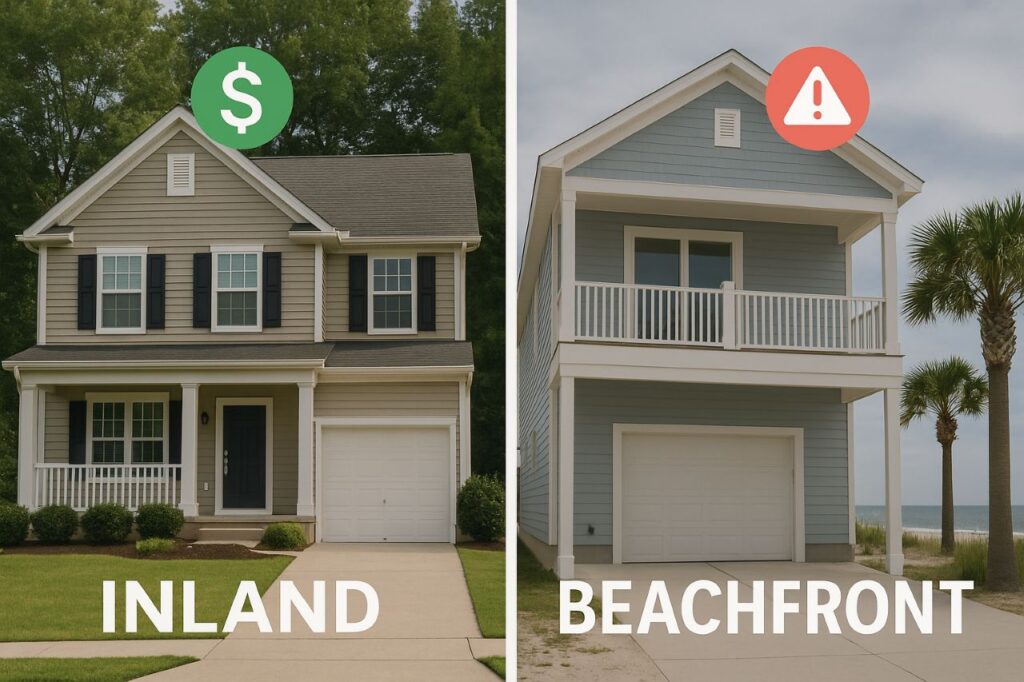
Home-ownership on the ocean presents beautiful views and an easy-going lifestyle—but it also presents special risk factors that require specialized coverage. Beachfront home insurance is quite distinct from regular home insurance based on higher exposure to natural catastrophes, weather damage, and the long-term breakdown of saltwater and dampness.
Whether you’re buying a new oceanfront home or reviewing your existing coverage, it’s important to know why beachfront home insurance differs from inland homeowner policies.
Increased Risk Translates to Higher Fees:
You’re simply closer to the nature’s most destructive powers when you’re on the coast—hurricanes, tropical storms, flooding, and erosion. All these risks translate into significantly higher fees for beachfront homes in contrast to houses that are farther inland.
Insurance firms consider a number of factors when computing premiums for beachfront residence insurance:
- Distance from the shoreline: Houses near the beach have greater risks of flooding and wind damage.
- Elevation: Properties with low elevations are at higher flood risk and may need to be built higher to be eligible for coverage.
- Local history of weather: Frequent hurricane occurrence and FEMA disaster declarations significantly affect your risk rating.
For instance, a Naples, Florida beachfront house could run more than $3,500 per year in just homeowners insurance, versus around $1,200 per year for the same kind of house in an inland location. And that’s not counting flood insurance, which is usually required for beachfront homes.
Tip: Use the FEMA Flood Map Service Center to find your home’s flood risk rating. Zones such as AE or VE mandate flood protection through the National Flood Insurance Program (NFIP) or private flood insurers.
Standard Policies Often Fall Short:
One widespread error that new beachfront homeowners make is the belief that standard homeowners’ insurance includes all perils. Sadly, most traditional policies exclude essential risks that are common to beach communities.
Here’s what most typical policies leave out:
- Flood damage: Uncovered unless you purchase an independent flood insurance policy through NFIP or private insurers.
- Windstorm damage: In states with hurricane history such as Florida, Louisiana, and the Carolinas, insurers usually mandate independent windstorm coverage.
- Salt air corrosion: Long-term exposure to salty air can cause damage to HVAC systems, metal fixtures, and roofs, but this is usually not included in base policies.
That’s why beachfront home insurance must be tailored to your property’s unique risk profile. It’s not just about the home’s market value—it’s about ensuring you’re protected from the most probable and expensive threats.
Example: A Galveston, Texas homeowner was disallowed a claim after salt corrosion destroyed their air conditioning system. Such progressive damage was standard policy and not covered except under a special beachfront home insurance rider.
Pro Tip: Always ask for a detailed risk analysis from your insurer. Specifically ask about coverage for salt air, windstorm, and floods. Don’t assume anything—get it all in writing.
Summary Tip:
Before choosing or renewing a beach house home insurance policy, take the time to consider:
- Your precise location and flood zone.
- Whether your residence complies with elevation and storm resistance requirements.
- The holes in your current homeowners insurance.
- Add-on policies or endorsements you might require.
Life on the beach is a fantasy—but it comes with non-negotiable responsibilities for insurance. An adequately structured beach house home insurance policy is your best protector against climate unpredictability and expensive surprises.
Types of Coverage You’ll Need
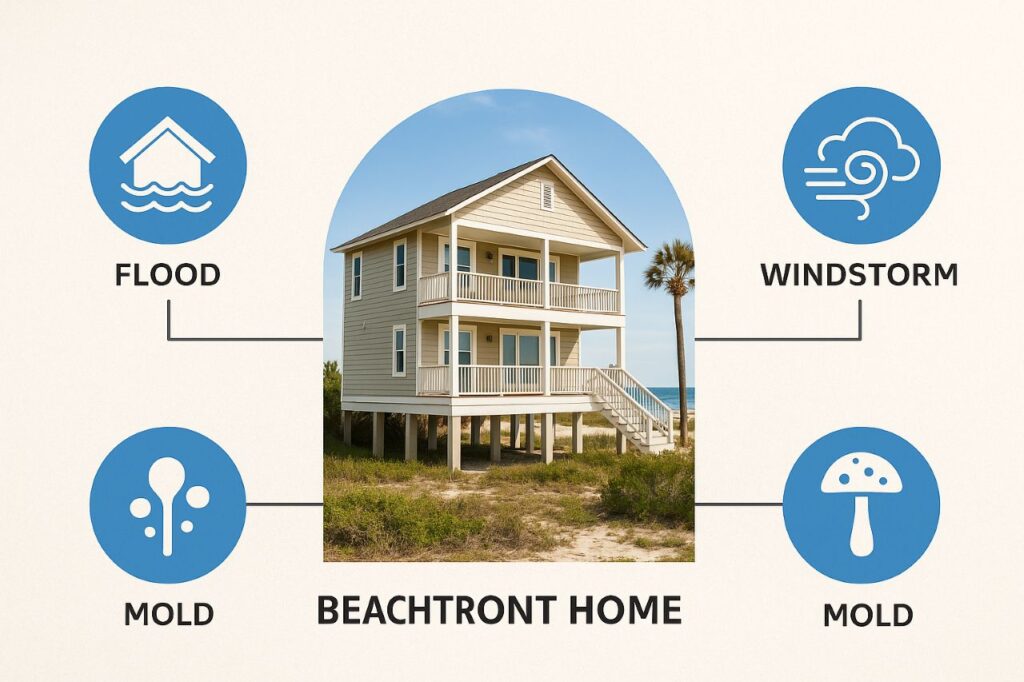
When protecting your coastal property, relying on a standard homeowners policy isn’t enough. A proper beachfront home insurance plan consists of multiple layers of protection to account for the unique risks posed by oceanfront living—floods, hurricanes, salt air corrosion, mold, and more. Let’s explore the essential types of coverage you’ll need to fully protect your investment.
Windstorm Insurance:
Windstorm coverage is an important component of any home insurance policy located along the beach, particularly in states vulnerable to hurricanes like Florida, Louisiana, and the Gulf Coast of Texas. These states are often pummeled by hurricane and tropical storm high-speed winds, leading to roof damage, broken glass, downed trees, and structural collapse.
Important facts:
- Windstorm coverage is frequently mandatory for mortgage companies in specified high-risk areas.
- It isn’t always part of a standard home policy, particularly in coastal states.
- In Florida and Texas, the coverage has to be added separately, often through a state-sponsored insurer like the Texas Windstorm Insurance Association (TWIA) or Florida’s Citizens Property Insurance Corporation.
Tip: Make sure to check if your beach house insurance has windstorm coverage. If it doesn’t, request an endorsement or separate policy. Also, ensure that the policy covers wind damage as well as wind-driven rain, which usually results in interior water damage.
Flood Insurance (NFIP or Private):
Flooding is one of the most common and destructive risks for coastal homeowners, yet it’s not covered under standard homeowner insurance. For a truly comprehensive beachfront home insurance plan, you’ll need to purchase flood insurance separately.
You have two main options:
1. National Flood Insurance Program (NFIP):
Managed by FEMA, the NFIP provides:
- Up to $250,000 for the home’s structure.
- Up to $100,000 for personal belongings.
However, it has limitations:
- No coverage for temporary living expenses.
- 30-day waiting period until coverage takes effect.
- Slower claims settlement than private providers.
More information: NFIP – FloodSmart.gov
2. Private Flood Insurance:
Increasingly, homeowners are looking to private flood insurers, who provide:
- Higher coverage amounts (well-suited for high-value beach homes).
- Faster payment of claims.
- Add-ons such as temporary living costs on an optional basis.
Tip: Residences in FEMA-designated AE or VE flood zones are considered high-risk. Use the FEMA Flood Map Service Center to verify your risk zone prior to requesting coverage.
Sewer Backup and Mold Coverage:
Salt air and moisture-prone environments lead to rapid growth of mold and sewer backup hazards in homes in beach areas. These perils aren’t usually included in standard homeowners policies and need to be endorsed separately.
- Sewer Backup Coverage:
- Is for damage by clogged or backed-up sewer lines that may be caused by storm surges or heavy rain.
- Is for damage by sewage backup to flooring, furniture, and appliances.
- Mold Coverage:
- Pays for mold remediation and removal caused by a covered water damage incident.
- Critical since mold grows so rapidly under the humid beach environment, particularly if it is not cleaned promptly.
Without such coverage, homeowners can be responsible for thousands of dollars in out-of-pocket repairs alone, not even considering possible health hazards from exposure to mold.
Tip: As an add-on to your beachfront dwelling insurance, request a sewer backup and mold remediation add-on or rider. These riders are usually inexpensive compared to the enormous cost of cleanup after flooding.
Bundle for Simplicity and Savings:
Because beach house insurance typically involves several individual policies (home, windstorm, flood, and rider), it can become complicated to keep track of them. Luckily, most insurance companies provide bundling discounts or streamlined claims handling when you utilize the same company.
Advantages of bundling:
- Simplified management with a single contact.
- Multiple-policy discounts (5% to 20% savings in most situations).
- Quicker claims process, particularly after a devastating storm or catastrophe.
Fast Tip: Request your insurance agent to bundle your homeowners, flood, and windstorm policies into a single beachfront home insurance policy. You’ll probably save money and minimize administrative woes.
By locking in these particular coverage and bundling them strategically, you’ll create a solid and adaptive beachfront home insurance plan that protects your property from the uncertain challenges of coastal life.
Real Costs: What to Expect for Premiums
Influencing Factors:
- Location: Homes on Florida’s Gulf Coast or California’s beaches carry higher premiums.
- Elevation and Construction: Elevated homes with hurricane-resistant features may reduce costs.
- Deductibles: Coastal homes often have percentage-based hurricane deductibles (e.g., 2% of home value).
Example Breakdown
| State | Avg. Premium (Yearly) | Flood Insurance Avg. |
|---|---|---|
| Florida | $3,500 | $800 (NFIP) |
| North Carolina | $2,200 | $600 (Private) |
| California | $2,800 | $500 (NFIP) |
Resource: Check current NFIP pricing and flood zone maps on FEMA.gov.
7 Shocking Pitfalls to Avoid Now
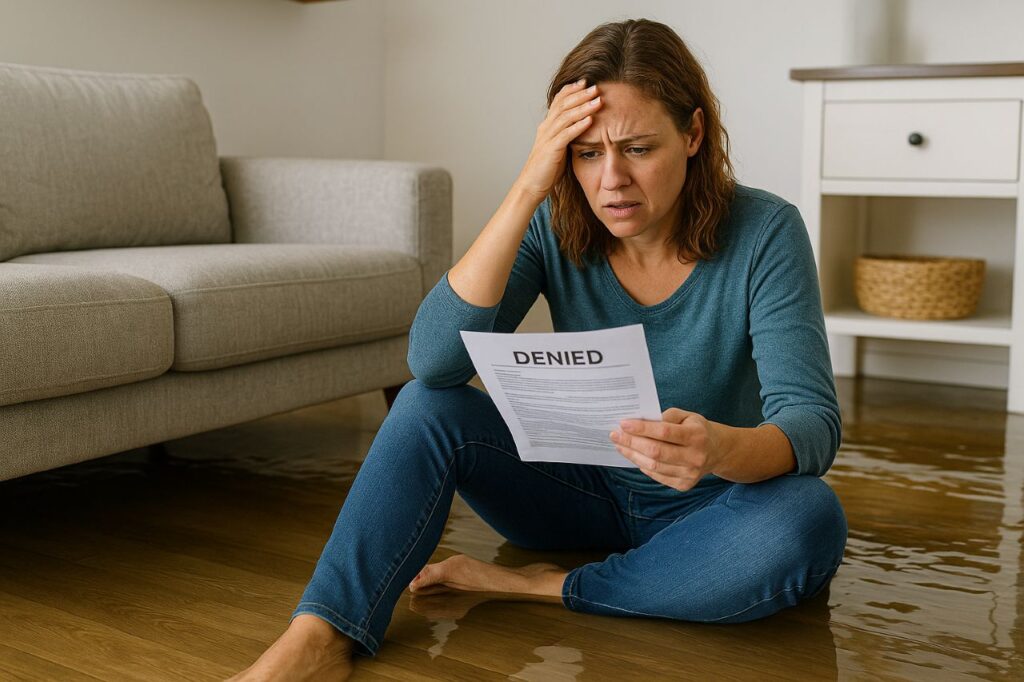
1. Assuming Flood is Covered:
The most perilous misunderstanding that owners have is perhaps that their regular home insurance policy includes flood protection. In reality, nearly all regular homeowner’s policies do not cover flooding due to natural occurrences such as hurricanes or excessive rain.
Thousands of homeowners realize this too late—after water has destroyed their flooring, drywall, and personal items. For example, in Hurricane Harvey, many Houston residents were surprised to realize that they had zero financial help from their home insurance companies for water damage because they didn’t carry a policy with flood coverage.
Tip: Always purchase a stand-alone flood insurance policy, either from the National Flood Insurance Program (NFIP) or private flood insurers. Utilize FEMA’s Flood Map Service Center to determine your home’s flood zone and risk level.
2. Waiving Windstorm Coverage:
If your beach home is in a hurricane area, you will need to carry windstorm coverage. Most homeowners do not carry this or assume that it is already covered under their basic policy.
In the Carolina, Texas, and Florida, you’ll be required by insurers to purchase windstorm coverage as an add-on. If you don’t purchase this rider, your wind damage claim—blown-off shingles, shattered windows, or destroyed roofs—will be denied.
In Hurricane Ian (2022), for example, many policyholders saw their claims rejected because they lacked this very essential coverage. The result? Enormous out-of-pocket costs that could have been prevented with prudence.
Tip: Contact your insurer and see if wind damage due to tropical storms or hurricanes is included, and if not, request a windstorm endorsement immediately.
3. Failing to Update Rebuilding Costs:
Another huge trap is using stale insurance valuations. If your policy hasn’t been revised in the last 2–3 years, it probably doesn’t contain current construction and labor costs.
Coastal homes, especially, require specialized materials, hurricane-resistant construction, and rigid code compliance—all of which are high-end priced. Post-COVID inflation, shortages of labor, and supply chain disruptions have only further fueled the cost of rebuilding even more.
Picture having a policy for $300,000 in damages, and your contractor is going to run $425,000 to bring the house up to code. That $125,000 you’ll have to come out of pocket.
Tip: Check your coverage levels annually for inflation, rising material costs, and local rebuilding rates.
4. Choosing the Cheapest Policy:
You may be tempted to go for the lowest premium—but it may bite you back. Low-premium policies have high deductibles, low coverage, and plenty of exclusions.
For instance, some simple policies can lack:
- Mold remediation.
- Transitional relocation or “loss of use.
- Sewer back-up.
- Debris removal.
These accumulate rapidly after a storm. Paying $300 less each year on a simple plan might cost you $25,000 in out-of-pocket repair or cost.
Tip: Balance coverage quality with cost. Always ask, “What does this policy not cover?” before you make a decision.
5. Ignore Policy Exclusions:
Such surprises await most policyholders on finding out what their policy does not cover. Land erosion, earth movement, foundation cracks, and saltwater damage are common exclusions in coastal policies.
Even some insurance companies exclude damage due to poor upkeep or sluggish leaks, which may be easily triggered under beachfront climatic conditions.
These exceptions are typically hidden in the small print—leaving the homeowner helpless when their claim is denied on a technicality.
Tip: Have your claim reviewed by an independent insurance agent or attorney. This is not a matter of trusting oral promises—get written proof of every inclusion.
6. Delaying Coverage Activation:
Timing is everything. Most insurers put a 15–30 day waiting period before policies for new windstorm or flood coverage become effective. If you buy insurance a week before hurricane season, your house could still be at risk.
During periods of increased vigilance or after an anticipated storm, even new policies could be put on hold temporarily by insurers. So, if you procrastinate, you may be locked out completely.
Tip: Don’t wait. Purchase and acquire protection ahead of time, especially if you live in a high-risk coastal community.
7. Failure to Document the Property:
When the disaster occurs, your case is only as strong as evidence. Without photos, receipts, and inventory lists, you may be facing a difficult time proving the size of your loss. Most homeowners do not have current documentation. They do not photograph recent updates, new appliances, or new materials. So, insurance adjusters can deny or downplay claims because there is no evidence.
Tip: Get clear, dated photographs of the exterior and interior of your house, possessions, and improvements. Save them to the cloud or off-site hard drive. Update this documentation every 6–12 months.
Expert Tips to Lower Premiums

Living near the coast comes at a cost, but there are several smart strategies to help you reduce your beachfront home insurance premiums—without compromising on protection. By reinforcing your home, improving your elevation, or adjusting policy features, you can make your property more insurable and budget-friendly. Below are expert-backed tips that can help you save money while maintaining the full coverage your beachfront property needs.
Fortify Your Home:
Insurers reward policyholders who proactively strengthen their homes against coastal threats. By making your home more resistant to storms, you not only improve safety but also qualify for substantial beachfront home insurance discounts.
Effective Fortification Strategies:
- Install hurricane shutters or impact-resistant windows to reduce wind damage.
- Upgrade to a reinforced roof with hurricane clips and sealed sheathing.
- Use water-resistant materials for walls, flooring, and insulation in flood-prone areas.
These fortifications lower the danger of large claims, which has encouraged many insurers to provide discounts of 10% to 25%. Homeowners in Florida, for example, can be eligible for savings under the My Safe Florida Home Program, which encourages storm-hardening initiatives by way of incentives and inspections.
Tip: Ask for a home wind mitigation inspection. This assessment can validate your improvements and lower your beachfront home insurance premiums.
Elevate Your Property:
Elevation is among the most significant determinants of flood insurance rates. Houses constructed above base flood elevation (BFE) levels are lower risk, resulting in considerable savings on both flood and beachfront house insurance rates.
How to Elevate:
- Construct on stilts or pilings, particularly in VE flood zones.
- Use flood vents to permit water to travel through without harming the foundation.
- Get an Elevation Certificate from a licensed surveyor to file with FEMA or your insurance company.
As reported by FEMA, homes raised even just a few feet above the BFE can reduce hundreds to thousands of dollars in annual flood insurance.
Example: An Outer Banks, NC, homeowner raised their beach house 4 feet and lowered its annual flood premium from $2,800 to $950.
Tip: Show your Elevation Certificate to your insurer when filing for NFIP discounts under your beachfront home insurance policy.
Take Increased Deductibles:
The simplest way to reduce your beachfront home insurance premium is through selecting a higher deductible. Most insurers provide percentage deductibles for claims related to hurricanes and windstorms (e.g., 2%, 5%).
Why It Matters:
- The greater the deductible, the more risk you bear, so you pay less initially.
- As an example, a 5% deductible on a $500,000 property equates to $25,000 out-of-pocket—so only worth it if you have available emergency funds.
Tip: Opt for a higher hurricane deductible but maintain your non-hurricane deductible lower. This puts risk and cost in proportion and doesn’t leave you vulnerable to financial loss on routine claims.
Alert: Don’t increase your deductible if you don’t have the funds to pay it if a big storm hits.
Bundling and Loyalty Discounts:
Bundling policies for your beach house with others such as auto, umbrella, or boat insurance can result in huge savings. Most insurance firms provide multi-policy savings of 10% or higher.
Bundling Benefits:
- Makes paying premiums and managing policies easier.
- Allows for coordinated handling of claims across home and auto losses following natural catastrophes.
- Creates trust with your insurer, which can eventually open up loyalty discounts.
Example: A Charleston, SC homeowner along the coast bundled their home, flood, auto, and umbrella coverage with the same insurer and saw a 15% discount on their annual premium.
Tip: Inquire about loyalty benefits for long-term coverage with the same company. Certain insurers provide additional discounts or deductible forgiveness upon a claim-free period.
Also look at providers that specialize in coastal coverage bundling, such as Allstate, Liberty Mutual, or Farmers, who have easy-to-use apps and customized coastal packages.
Although beach house insurance is a required cost, you can manage your premiums with the proper combination of renovations, smart policy decisions, and insurer devotion. These preventive actions not only save you money on premiums, but they also increase the value of your property and your sense of security during hurricane season.
Conclusion – Beachfront Home Insurance
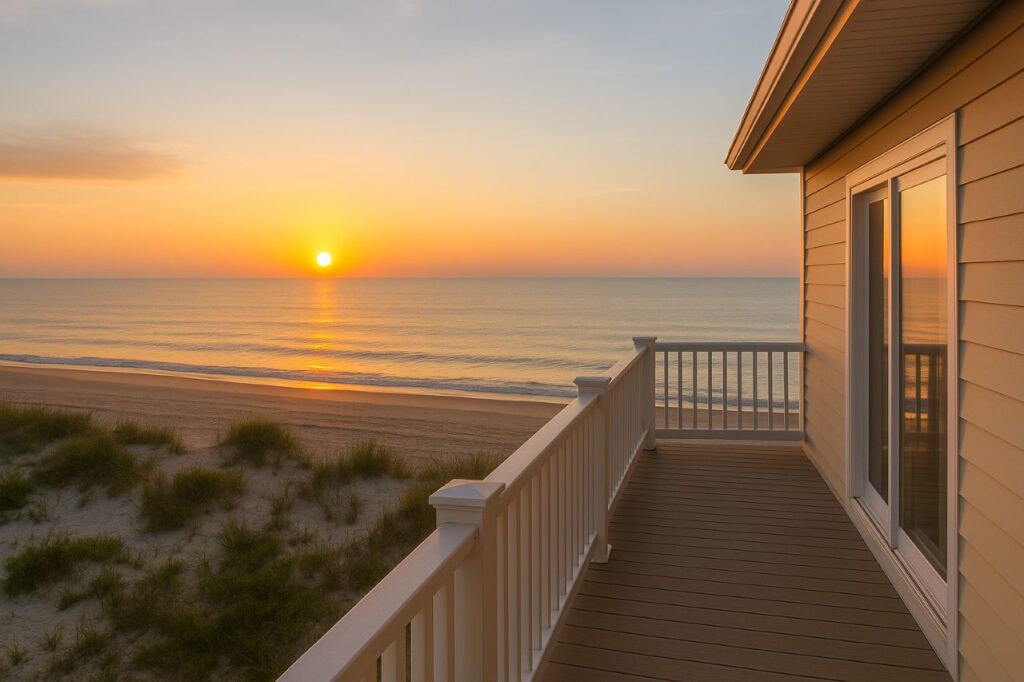
Beachfront house insurance is not another expense—it’s your shield against nature’s unexpected fury. With increasing sea levels, intense hurricanes, and the impacts of climate change, having full coverage is more urgent than ever. Not having proper insurance can leave one facing crippling financial loss and emotional distress during already traumatic circumstances.
Take the time to evaluate your property’s risks, learn about your policy choices, and consult with trusted experts. Whether you’ve been a longtime coastal resident or you’re planning your beach vacation home, the proper beachfront home insurance will safeguard your investment, your loved ones, and your peace of mind.
Ready to safeguard your beachfront paradise? Contact a certified coastal insurance agent now and ensure you’re completely protected before the next storm rolls in.
Also Read: Mercer Home and Auto Insurance: 7 Shocking Facts
Frequently Asked Questions (FAQs)
What is beachfront home insurance?
Beachfront home insurance is specialized coverage designed to protect homes located near the ocean or coastlines. It typically includes additional policies for flood, windstorm, and saltwater damage not covered in standard homeowners insurance.
Why is beachfront home insurance more expensive?
Beachfront properties are at higher risk for flooding, hurricanes, and erosion, which increases the cost of insurance. Premiums reflect the greater likelihood of severe weather damage and repair costs.
Is flood insurance included in beachfront home insurance?
No. Flood insurance must usually be purchased separately through the National Flood Insurance Program (NFIP) or private insurers. Most standard policies do not cover flood damage
What additional coverage should I consider for a coastal home?
Besides basic homeowners insurance, consider windstorm insurance, flood coverage, sewer backup, and mold remediation add-ons to fully protect your coastal property.
Can I lower my beachfront home insurance premiums?
Yes. You can lower premiums by elevating your home, installing hurricane-resistant features, bundling insurance policies, and increasing your deductible.
Do I need an elevation certificate for flood insurance?
Yes. An elevation certificate can help reduce your NFIP flood insurance premium by showing your home is built above the base flood elevation level.
How do I choose the best insurance provider for my beachfront home?
Look for providers with strong financial ratings (A or higher by AM Best), coastal experience, customizable policies, and good customer reviews on platforms like BBB and Trustpilot.

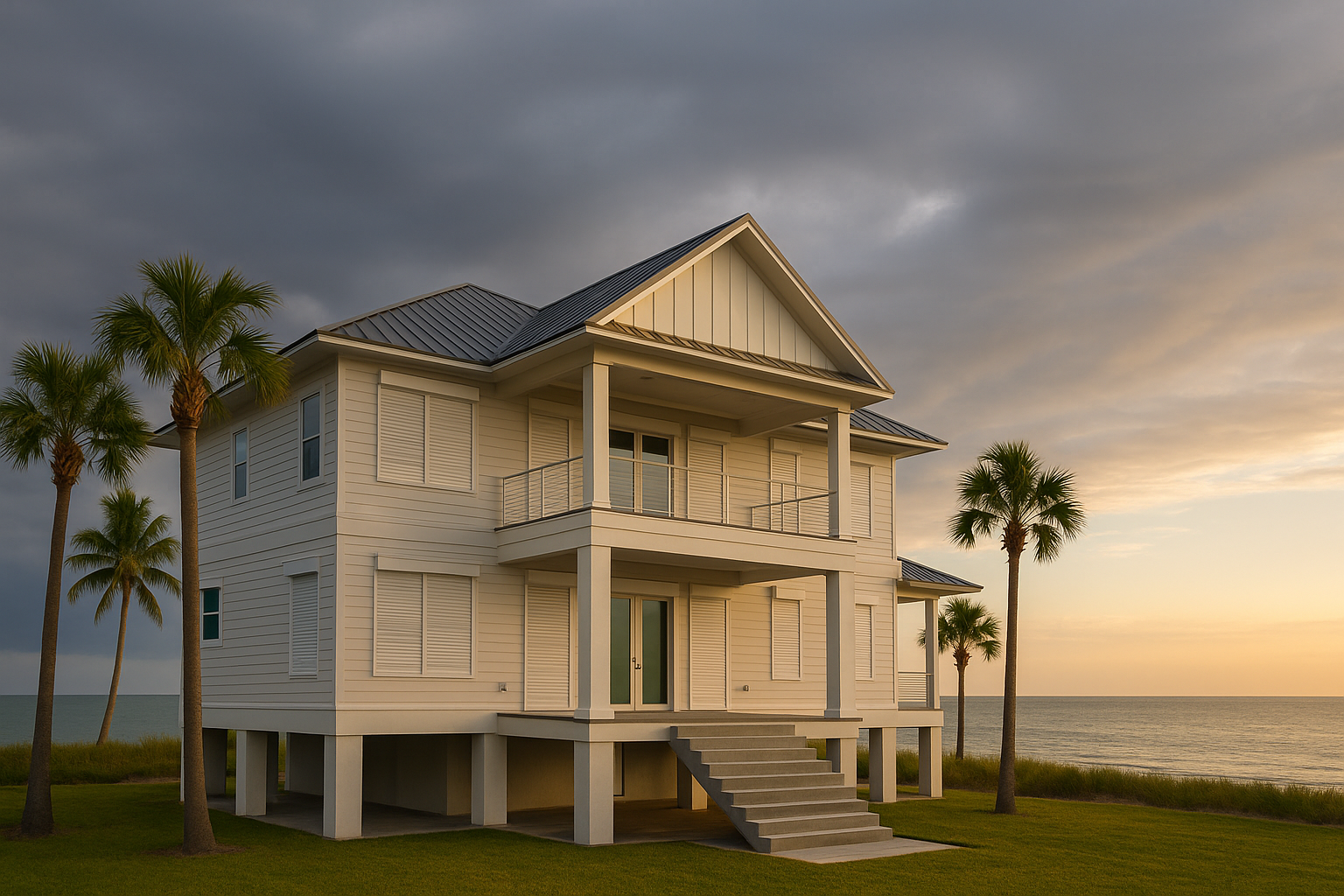




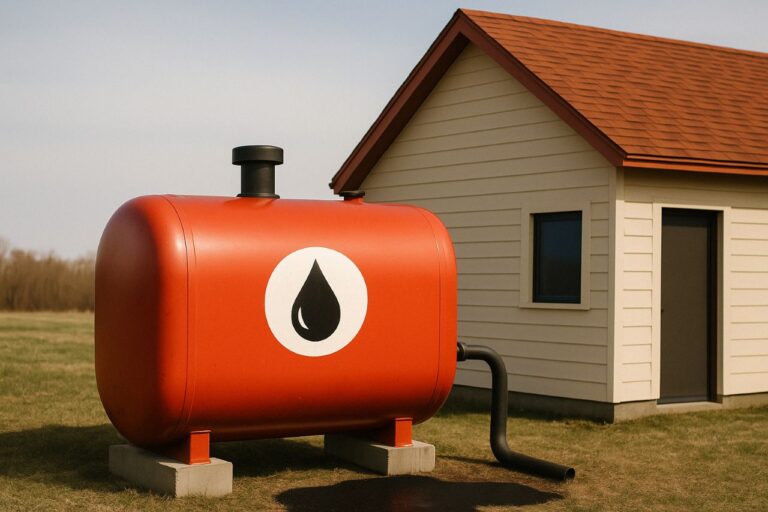

One Comment